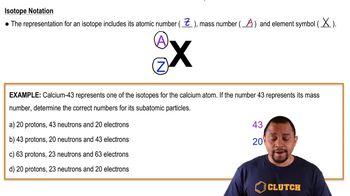Here are the essential concepts you must grasp in order to answer the question correctly.
Nuclear Reactions
Nuclear reactions involve changes in an atom's nucleus and can result in the transformation of one element into another. They typically include the emission or absorption of particles such as neutrons (n), alpha particles (α), and beta particles (β). Understanding the types of nuclear reactions is essential for balancing equations, as it helps identify the reactants and products involved.
Recommended video:
Balancing Nuclear Equations
Balancing nuclear equations requires ensuring that both the mass number and atomic number are conserved during the reaction. This means that the sum of the mass numbers and the sum of the atomic numbers on the reactant side must equal those on the product side. Mastery of this concept is crucial for accurately writing and interpreting nuclear equations.
Recommended video:
Balancing Chemical Equations
Isotopes and Atomic Notation
Isotopes are variants of a particular chemical element that have the same number of protons but different numbers of neutrons, resulting in different mass numbers. Atomic notation, which includes the element symbol, mass number, and atomic number, is used to represent isotopes. Familiarity with isotopes and their notation is vital for correctly identifying and writing nuclear reactions.
Recommended video:
 Verified step by step guidance
Verified step by step guidance

